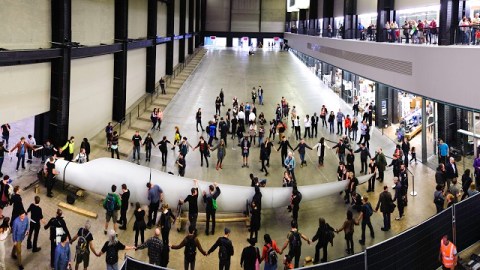Are Museums Responsible for Their Donors’ Actions?

“Follow the Money,” the informant known only as “Deep Throat” told Woodward and Bernstein during their investigation into the Watergate Scandal that they titled All the President’s Men. Follow the flow of cash behind any endeavor and you’ll find the true source, which can be surprising and, too often, dismaying. Art museums, those bastions of civilization, quite often find themselves in the position of accepting donations from less-than-civilized parties, specifically corporations polluting the world. A group calling itself Liberate Tate staged their latest (and largest) protest against the Tate Modern’s acceptance of money from British Petroleum, aka, BP, who are best remembered for their Gulf of Mexico oil spill in 2010 that continues to plague that region. Should we hold museums responsible for their donors’ actions?
Last Saturday, members of Liberate Tate carried a giant wind turbine blade into the Tate Modern’s Turbine Hall—a nice touch of ironic humor. (A nice video of the proceedings can be found here.) To the dismay of the overwhelmed museum guards, the protestors carried in their “gift” and asked that it be made part of the permanent collection (image above of the “performance” around the turbine piece). BP sponsors British arts institutions overall to the tune of more than a million pounds per year. Last December, Liberate Tate teamed with other environmentally minded groups to present Nicholas Serota, the Tate’s director, with a petition signed by 8,000 museum members and visitors. Things got messier from there: protestors poured 5 gallons of molasses down Tate Britain’s stairs at its summer party and later released helium balloons bearing dead fish in the Turbine Hall, which guards brought back to Earth with air rifles. Retreating from the gross out tactics, Liberate Tate went big in search of attention and won.
With the environment on everyone’s mind in one way or another, the question of where an organization stands on the issue weighs heavier on their reputation than ever before. Who you associate with—especially monetarily—makes a huge difference. If the Tate Modern accepts BP’s money, they also need to accept the consequences. However, in the Tate’s defense, cultural institutions in this age of economic unrest may not be in the position to be choosy when it comes to donors. Scruples may lose out to harsh financial realities. If funds keep the lights on and the doors open, can we quibble over who provided them?
I don’t think there are easy answers to these questions, but Liberate Tate performs a valuable public service in bringing them into the spotlight—not just in the case of the Tate Modern, but for all museums worldwide. Liberate Tate invites anyone interested in this issue to sign their “Open Letter to Nicholas Serota,” which will be presented to the Tate as Liberate Tate’s next action. As the letter states, “There is a contradiction in Tate being committed to climate action while also being heavily associated to a company whose business model is binding us to a catastrophically dangerous future and outdated energy model.” Whether that contradiction is irreconcilable is an individual choice, but at least we now know to “follow the money” even when museums are involved. If Serota’s truly the “modern man” of Calvin Tomkins’ recent profile and the cultural visionary many consider him to be, he’ll make the right choice for the Tate and for the public.
[Image:The Gift. Performance by Liberate Tate. Tate Modern, 7 July 2012. Credit: Ian Buswell.]





